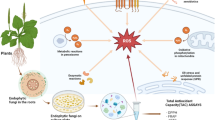Summary
A model system of 19 agar platelets colonized by the lignocellulolytic fungus,Agrocybe aegerita in which the platelets were exclusively connected by mycelial bridges is reported. The distribution patterns of109CdCl2 and203HgCl2 in the platelets and translocation of the metal ions into the fruiting bodies formed at the periphery of the system have been studied at 3 different concentrations (10, 110, and 510 μg CdCl2 and 12.3, 112.3, and 512.3 μg HgCl2, respectively per experimental dish). At all 3 concentrations, the amount translocated was not proportional to the amount of the heavy metals applied. When expressed as a percentage, both metal ions were translocated into the fruiting bodies most efficiently at the lowest concentration. At the highest concentration, obvious toxic lesion of the system was accompanied by an increased influx of the ions into regions in the vicinity of the point of application but reduced translocation into the fruiting bodies.
The distribution patterns found at all 3 concentrations were metal specific. More mercury than cadmium was always translocated into the fruiting bodies, thus confirming our previous results (Brunnert and Zadražil 1980).
The length of incubation of the metal salts in the system had no effect on the amounts translocated into the fruiting bodies.
Similar content being viewed by others
References
Brunnert H, Zadražil F (1979) The cycling of cadmium and mercury between substrate and fruiting bodies ofAgrocybe aegerita (a fungal model system). Eur J Appl Microbiol Biotechnol 6:389–395
Brunnert H, Zadražil F (1980) Translocation of cadmium and mercury in straw columns colonized by the fungusPleurotus cornucopiae Paul ex Fr. Eur J Appl Microbiol Bitoechnol 10:145–154
Howard AJ (1978) Translocation in fungi. Trans Br mycol Soc 70:265–269
Jennings DH, Thornton JD, Galpin MFJ, Coggins CR (1974) Translocation in fungi. Symposia Soc Exp Biol Cambridge 28:136–156
Le Tourneau D (1978) Inhibition of sclerotial formation ofSclerotium rolfsii by cadmium. Mycologia 70:849–852
Littlefield LJ, Wilcoxson RD, Sudia TW (1965) Translocation of Phosphorus-32 inRhizoctonia solani. Phytopathology 55:536–542
Littlefield LJ (1967) Phosphorus-32 accumulation inRhizoctonia solani Sclerotia. Phytopathology 57:1053–1055
Lucas RL (1977) The movement of nutrients through fungal mycelium. Trans Br mycol Soc 69:1–9
Read DJ, Stribley DP (1975) Diffusion and translocation in some fungal culture systems. Trans Br mycol Soc 64:381–388
Thrower LB, Thrower SL (1968) Movement of nutrients in fungi II. The effect of reproductive structures. Aust J Bot 16:81–87
Wilcoxson RD, Sudia TW (1968) Translocation in fungi. Bot Rev 34:32–50
Zadražil F, Brunnert H (1979) Der Einfluß von Ammoniumnitrat auf das Wachstum und das Strohabbauvermögen höherer Pilze. Z Pflanzenernaehr Bodenkd 142:446–455
Author information
Authors and Affiliations
Rights and permissions
About this article
Cite this article
Brunnert, H., Zadražil, F. Translocation of cadmium and mercury into the fruiting bodies ofAgrocybe aegerita in a model system using agar platelets as substrate. European J. Appl. Microbiol. Biotechnol. 12, 179–182 (1981). https://doi.org/10.1007/BF01008340
Received:
Issue Date:
DOI: https://doi.org/10.1007/BF01008340




